Primary navigation
White woodland plants
When you are looking for bluebells in woodlands in the British Isles, you might also spot some of these common woodland plants.

Bastard balm, Melittis melissophyllum, Spain. Mainly a Mediterranean species, in Britain it is only found in south-western England where it is rare and declining. It is grown in gardens for its attractive flowers. It has strong-smelling foliage. See map for more information about its distribution. © F.J. Rumsey

Greater butterfly orchid, Platanthera chlorantha, Buckinghamshire. Widely distributed throughout the UK but scarce and declining. Even when it is not producing its open spike of white, long-spurred flowers, it is recognisable by its broad, blunt-ended leaves. It normally has two of these. See map for more information about its distribution. © F.J. Rumsey
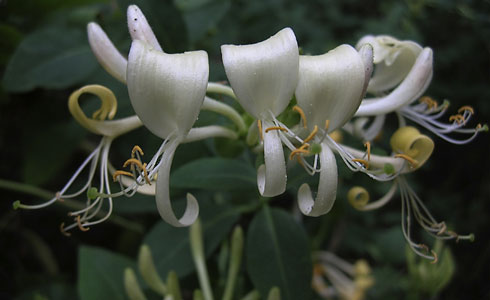
Honeysuckle, Lonicera periclymenum, Epping, Greater London. Widespread throughout the British Isles. Cultivated varieties of the plant are also commonly grown in gardens and sometimes escape. See map for more information about its distribution. © M.A. Spencer
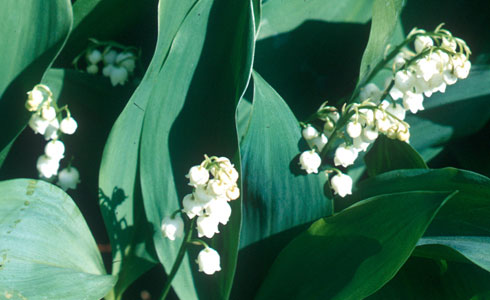
Lily of the valley, Convallaria majalis, Greater London. Usually restricted to ash woods in north and western Britian as well as acidic woods in south east England. The native range is often hard to be sure of as the plant often escapes from cultivation. See map for more information about its distribution. © M.A. Spencer
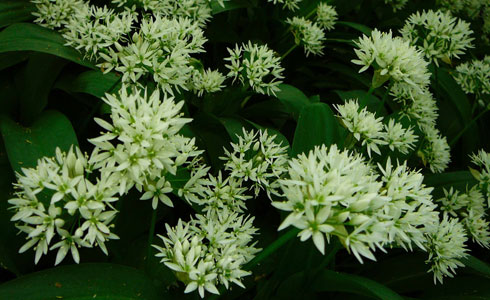
Ramsons, Allium ursinum, Greater London. Widely distributed throughout the Birtish Isles, it often grows in wetter soils than bluebells and can form large colonies. It has a strong garlicky odour and is therefore sometimes known as 'wild garlic'. See map for more information about its distribution. © M.A. Spencer

Solomon's seal, Polygonatum multiflorum, Hants. Widespread in the UK but its native range is now difficult to determine as it is frequently grown in gardens and escapes from them. It is most likely to be native in Ash woodlands as it grows with other ancient woodland indicators such as Early-purple orchids. See map for more information about its distribution. © F.J. Rumsey.
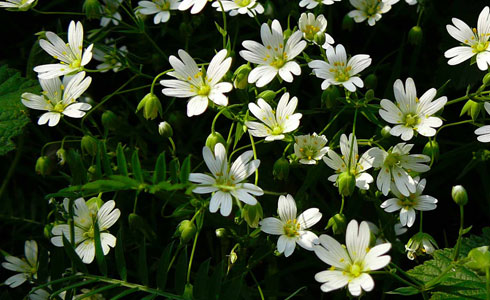
Greater stitchwort, Stellaria holostea, Surrey. Widespread across most of the UK, except northern Scotland and the Western Isles. See map for more information about its distribution. © M.A. Spencer
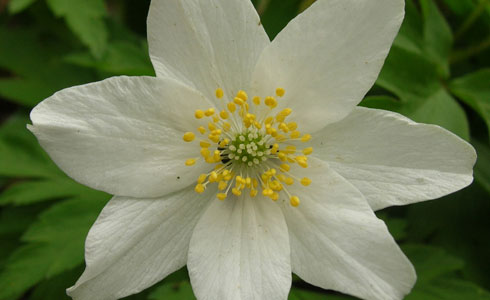
Wood anemone, Anemone nemorosa, Northamptonshire. Widespread across most of the British Isles. This plant is sometimes grown in gardens and may occur as an escape. Occasionally, there are variants tinged with pink, purple or blue. See map for more information about its distribution. © M.A. Spencer.

Woodruff, Galium odorata, Surrey. Widespread across most of the UK, except northern Scotland. This plant is sometimes grown in gardens and may occur as an escape. The plant has a strong sweet hay-like smell when it is dried. See map for more information about its distribution. © M.A. Spencer.

Wood sorrel, Oxalis acetosella, Surrey. Widespread across most of the UK, except parts of eastern England. This plant is rarely grown in gardens but non-native Oxalis species occur frequently as weeds, most of which have pink or yellow flowers. See map for more information about their distribution © F. J. Rumsey
Related information
Toolbox
- Contact and enquiries
- Accessibility
- Site map
- Website terms of use
- © The Trustees of the Natural History Museum, London
- Information about cookies
- Mobile
